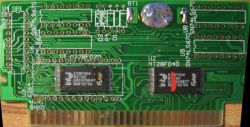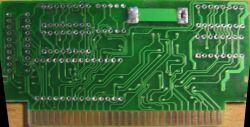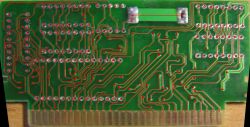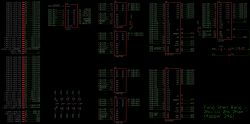Here's an example script of NROM (Mapper 0):
Code:
board <- {
mappernum = 0,
cpu_romsize = 0x8000, cpu_banksize = 0x4000,
ppu_romsize = 0x2000, ppu_banksize = 0x2000,
ppu_ramfind = false, vram_mirrorfind = true
};
function cpu_dump (d, pagesize, banksize)
{
cpu_read (d, 0x8000, 0x4000);
cpu_read (d, 0xc000, 0x4000);
}
function ppu_dump (d, pagesize, banksize)
{
ppu_read (d, 0, banksize);
}
Or more complex MMC3 (Mapper 4):
Code:
board <- {
mappernum = 4, vram_mirrorfind = false, ppu_ramfind = true,
cpu_rom = {
size_base = 2 * mega, size_max = 4 * mega,
banksize = 0x2000,
},
cpu_ram = {
size_base = 0x2000, size_max = 0x2000,
banksize = 0x2000,
},
ppu_rom = {
size_base = 2 * mega, size_max = 2 * mega,
banksize = 0x0400
}
};
function cpu_dump(d, pagesize, banksize)
{
cpu_write(d, 0xa001, 0); //disable W-RAM
for(local i = 0; i < pagesize - 2; i += 2){
cpu_write(d, 0x8000, 6);
cpu_write(d, 0x8001, i);
cpu_write(d, 0x8000, 7);
cpu_write(d, 0x8001, i | 1);
cpu_read(d, 0x8000, banksize * 2);
}
cpu_read(d, 0xc000, banksize * 2);
}
function ppu_dump(d, pagesize, banksize)
{
for(local i = 0; i < pagesize; i+=4){
cpu_write(d, 0x8000, 2);
cpu_write(d, 0x8001, i);
cpu_write(d, 0x8000, 3);
cpu_write(d, 0x8001, i | 1);
cpu_write(d, 0x8000, 4);
cpu_write(d, 0x8001, i | 2);
cpu_write(d, 0x8000, 5);
cpu_write(d, 0x8001, i | 3);
ppu_read(d, 0x1000, banksize * 4);
}
}
/*
http://nesdevwiki.org/wiki/MMC3
PRG RAM protect ($A001-$BFFF, odd)
7 bit 0
---- ----
RWxx xxxx
||
|+-------- Write protection (0: allow writes; 1: deny writes)
+--------- Chip enable (0: disable chip; 1: enable chip)
*/
function cpu_ram_access(d, pagesize, banksize)
{
cpu_write(d, 0xa001, 0x80);
cpu_ramrw(d, 0x6000, banksize);
cpu_write(d, 0xa001, 0x40);
}
/*
CPU memory bank for T*ROM
cpu address|rom address |page|task
$8000-$9fff|0x02000-0x03fff|1 |write 0x2aaa
$a000-$bfff|n * 0x2000 |n |write area
$c000-$ffff|0x7c000-0x7ffff|fix |write 0x5555, boot area
PPU memory bank for TLROM TKROM TKSROM
ppu address|rom address |page|task
$0000-$07ff|0x02800-0x02fff|0x0a|write 0x2aaa
$0800-$0fff|0x05000-0x057ff|0x14|write 0x5555
$1000-$1fff|n * 0x1000 |n |write area
*/
function program_initalize(d, cpu_banksize, ppu_banksize)
{
cpu_write(d, 0xa001, 0); //disable W-RAM
cpu_command(d, 0x0000, 0xa000, cpu_banksize);
cpu_command(d, 0x2aaa, 0x8000, cpu_banksize);
cpu_command(d, 0x5555, 0xc000, 0x4000);
cpu_write(d, 0x8000, 7);
cpu_write(d, 0x8001, 0);
cpu_write(d, 0x8000, 6);
cpu_write(d, 0x8001, 1);
ppu_command(d, 0x0000, 0x1000, ppu_banksize);
ppu_command(d, 0x2aaa, 0x0000, 0x0800);
ppu_command(d, 0x5555, 0x0800, 0x0800);
cpu_write(d, 0x8000, 2);
cpu_write(d, 0x8001, 0);
cpu_write(d, 0x8000, 0);
cpu_write(d, 0x8001, 0x0a);
cpu_write(d, 0x8000, 1);
cpu_write(d, 0x8001, 0x14);
}
function cpu_transfer(d, start, end, cpu_banksize)
{
for(local i = start; i < end - 2; i += 1){
cpu_write(d, 0x8000, 7);
cpu_write(d, 0x8001, i);
cpu_program(d, 0xa000, cpu_banksize);
}
cpu_program(d, 0xc000, cpu_banksize * 2)
}
function ppu_transfer(d, start, end, ppu_banksize)
{
for(local i = start; i < end; i += 4){
cpu_write(d, 0x8000, 2);
cpu_write(d, 0x8001, i);
cpu_write(d, 0x8000, 3);
cpu_write(d, 0x8001, i | 1);
cpu_write(d, 0x8000, 4);
cpu_write(d, 0x8001, i | 2);
cpu_write(d, 0x8000, 5);
cpu_write(d, 0x8001, i | 3);
ppu_program(d, 0x1000, ppu_banksize * 4);
}
}
And last not least a 63in1 script:
Code:
board <- {
mappernum = 130, //Need to convert to UNIF format with BMC-Ghostbusters63in1
cpu_romsize = 0x180000, cpu_banksize = 0x8000,
ppu_romsize = 0, ppu_banksize = 0x2000,
ppu_ramfind = false, vram_mirrorfind = false
};
function cpu_dump(d, pagesize, banksize)
{
// ROM Chip. Only 0, 2 and 3 are used
for(local chip = 0; chip < 4; chip += 1){
if (chip != 1) {
// High bit for ROM chip select
cpu_write(d, 0x8001, chip >> 1);
// Bank. 512/32 = 16 banks per chip
for(local i = 0; i < 16; i += 1){
// Low bit for ROM chip select + bank select.
cpu_write(d, 0x8000, ((chip & 1) << 7) + (i << 1));
cpu_read(d, 0x8000, banksize/2); //Read 32KB bank from $8000-FFFF
cpu_read(d, 0xC000, banksize/2); //Read 32KB bank from $8000-FFFF
}
}
}
}
Maybe someone get the idea and could make a script for mapper 246 so I can dump the cartridge and provide the differences?




